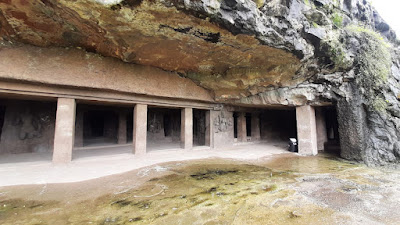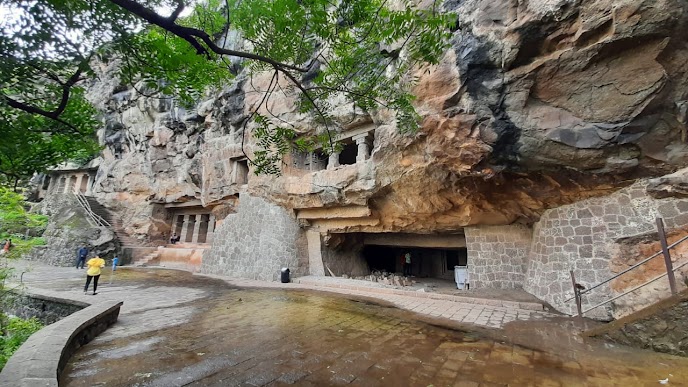History of Ancient Archaeological Rock Carving in India
Hinayana & Mahayana Sects:
There are many sects of Buddhism in the world but among them Hinayana and Mahayana are the major sects. Once we understand the Hinayana and Mahayana sects it becomes easy to understand these caves.
After the
Mahaparinirvana of Lord Gautama Buddha, for about 100 years, Buddhist monks and
followers of Buddhism practiced according to the original thoughts of Gautama
Buddha. At that time, Lord Gautama Buddha was worshiped in the form of a stupa.
There is such a stupa in Chaitya Caves in Aurangabad. Also, there are no Idols
carved on the wall of this Chaitya cave, because idol worship was not
acceptable at that time, but at the same time there were some followers among
these followers who thought that Lord Gautama Buddha was an incarnation of God.
Similarly, during the reign of Emperor Kanishka, one hundred years after Lord
Gautama Buddha's Mahaparinirvana, a religious council was held in India. In
this religious council, there were internal disputes among Buddhist monks and
two sects of Buddhism were formed. One sect was Hinayana and the other was
Mahayana. Both Hinayana and Mahayana are Sanskrit words. Hina means small and
Yana means ship. In short, Hinayana was a small group of Buddhist monks, while
Mahayana was a large group of monks. Hinayana is also called Theravada. This
sect practices according to the original teachings of Lord Gautama Buddha. They
did not accept idol worship. The Hinayana sect is found mainly in India, Burma,
Thailand, Cambodia, Sri Lanka and Laos. Buddhist monks of the Hinayana sect
wear saffron colored clothes.
In the Mahayana
sect, Lord Gautama Buddha is worshiped in the form of a god. This sect accepts
idol worship and the Buddhist monks of this sect wear dark red brown colored clothes.
For example, the Dalai Lama belongs to the Mahayana sect. The Mahayana sect has
expanded to a very large extent. This sect is mainly found in China, Tibet,
Japan, Mongolia, South Korea, North Korea, Vietnam, Philippines, Taiwan and
tundra region etc.
Information about caves:
Cave No 7:
This is the
most beautiful cave. It is a vihara with pillars carved outside it, followed by
a Hall or verandah. On the walls of verandah we can see various idols carved
out of stone. Behind the verandah is the sanctorum in which we can see magnificent
statue of Lord Gautama Buddha in the Dhammachakrapravartana state.
All the pillars have fine carvings, flowers of different shapes are carved on the pillars. On the walls of the sanctum there are idols of men and women, different ornaments can be seen carved on the body of the women. Rooms of various sizes are carved out around santum to live for Buddhist monks. It seems that these rooms were probably used by Buddhist monks to live and meditate. This vihara was built between 700 and 800 AD. This cave is almost twelve hundred years old. These caves are a unique example of Architecture and Geometry.
At that time,
the tools for engraving were not as developed as they are today, except chisels
and hammers. So think how long it would have taken to carve out such a huge
work with just a chisel and hammer. Looking at the vastness and magnificence of
the caves, these caves must have been carved for many years. Some caves date
back to AD 700-800. It means these caves were not carved by just one generation.
In short, all these caves were carved by about Eight to Ten generations and
each generation has done better sculpture than the previous generation. The
magnificence and beauty of these caves is indescribable.
Chaitya Cave No 4:
This is a
vihara, the oldest of the caves available in Aurangabad. Chaitya cave was
carved in 100 AD. This cave was carved in the beginning of AD.
There are no
carvings on the pillars, there are no carvings on the roof arch and the walls
of the chaityagriha. This is the only cave in the Aurangabad caves without
carvings or carvings of any kind. There is a stupa inside but no carvings.
Because of that, looking at this cave, we feels that this cave should be from
the very early period after Lord Gautama Buddha's Mahaparinirvana, that is,
before the Hinayana and Mahayana sects. As this cave is the oldest, the roof of
this cave is seen to have fallen a little. Perhaps this chaityagriha was used
for community prayer or It must have been done for worship.
Cave No 1:
This is a
Mahayana cave, the only cave with doors and windows. This is a vihara. The
carvings on its doors and windows are amazing. Inside this cave we can see
about 12 to 15 pillars. These pillars are carved to support the weight of the
ceiling. Each pillar has fine carvings, a circular band and rose petals carved
on it. Various shapes of idols are carved on pillers. Each pillar here is in a
straight line and at right angles. The floor of the cave and the surface of the
roof are exactly parallel. In the sanctum sanctorum of the same cave, we can
see the idol of Lord Gautama Buddha in Dhammachakrapravartana state. Outside
the sanctorum there we can see two tall gatekeepers idol, one of them has a
lotus flower in his hand and the other has a serpent on his head. This cave has
the largest number of carved idols from entire Aurangabad caves. These idols
range from very small to large in size. All the idols in this cave are less
worn than the idols in other caves. There is no consensus about when this cave
was built, so it seems that this cave was carved last.
If we look at
the caves of Aurangabad and then look at the caves of Ajanta Verul, one
question surely arises. Perhaps the digging of these caves started from
Aurangabad and the subsequent generations carved the caves of Ajanta-Verul
because there is a pre-Mahayana and Hinayana sect of Chaitya, also If they were
carved after Ajanta-Verul caves, they would of course have been made better
than Ajanta Verul. we can see that there are many similarities between
Aurangabad caves and Ajanta Verul caves.
Aurangabad
Caves are very little promoted and disseminated, perhaps many of us are not
even aware of the presence of such amazing caves and hence the number of
tourists who visit here can be counted on the fingers.
What then! Are
you coming to see these caves?







Comments
Post a Comment